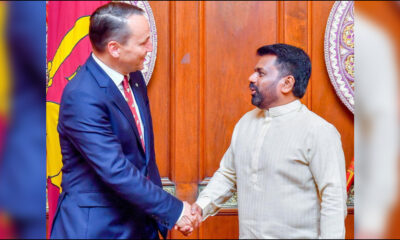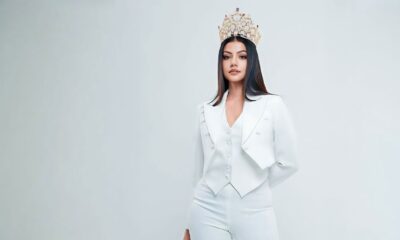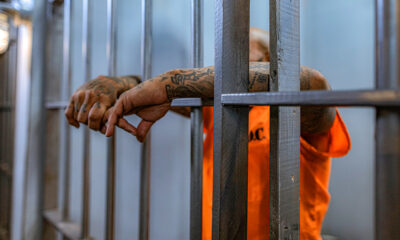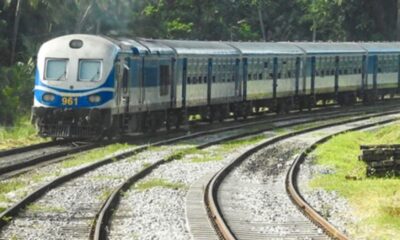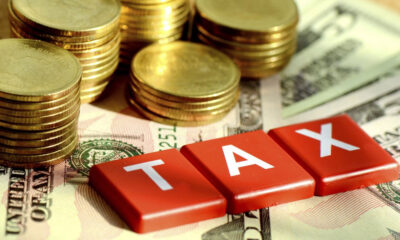FEATURES
Coming out of the crisis – Geopolitics and IMF – Part I
Published
3 years agoon
By
editor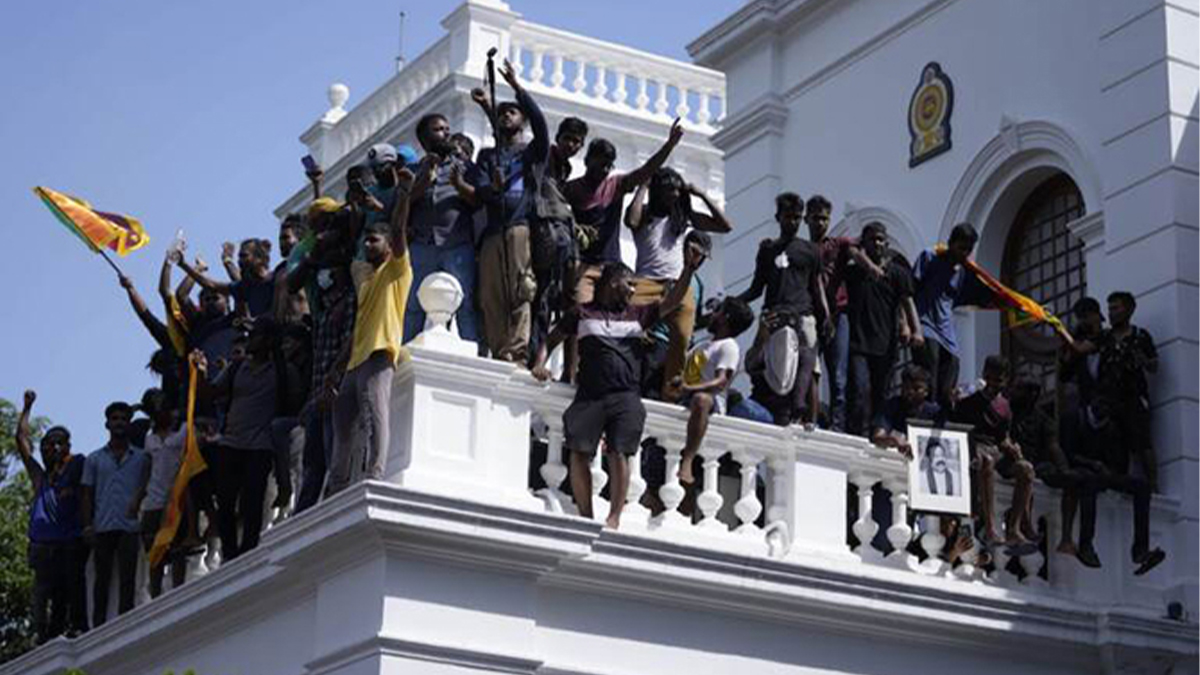
Politics of #GotaGoHome protests and arrival of IMF
Present economic chaos is neither “pandemic” made nor “Gota” made crisis per se. It was in the making with the free market economy for decades, was accelerated on top gear during the second presidential tenure of Mahinda Rajapaksa and continued with less noise through “yahapalanaya” of PM Wickramasinghe. The heavily corrupt and looted economy by then got stuck with the Covid-19 pandemic and was shattered into smithereens under President Gotabhaya Rajapaksa, handled by a set of loony amateurs.
Initial collapse of the economy was spoken of in the agricultural sector with the total ban on chemical fertiliser and agri-inputs in end April 2021. By December 2021 there was growing resentment in the urban middleclass over quality of LP gas and its shortage with power cuts and fuel shortages bringing the forex crisis into the open in early January 2022. Towards mid-February, with urban middleclass life going haywire, Gota government was challenged by them at popular city locations. That led to the new middleclass protest culture at Galle face as the #GotaGoHome youth protest in first week of April with heavy campaigning on social media.
Youth groups that originally flagged the #GotaGoHome protest have now basically settled with unforeseen, unexpected double entry of Wickramasinghe as Executive President, heading a seemingly non-Rajapaksa government. #GotaGoHome campaigners have also gone silent on their initial public calls to reject the 225 Member parliament as corrupt. Recent appointments of 37 State Ministers have also left out 03 of the 04 Rajapaksas in parliament. With a few days pause on “power cuts” followed by a 01 hour plus tolerable cut with fuel queues out of sight, the urban middleclass has gradually gone back to their usual lifestyle, though with some uncertainty.
Political groups in the fringe who picked up on the protests from Galle face green took them out onto the streets as violent street fights inviting heavy repression from Wickramasinghe rule. Their call against arrests of “peaceful protesters” are being isolated from society, with the urban middleclass focussed more on “social stability necessary” and the would-be outcome of the “IMF bailout”. The repression meanwhile continues using the dreadful Prevention of Terrorism Act (PTA) with President Wickramasinghe least concerned about UNHRC Sessions, their Reports and Resolutions over 12 years old and with nothing conclusive. They don’t play adversely anymore on Wickramasinghe in Sri Lankan politics.
Geo-politics of “regime change”
Wickramasinghe first brought in as PM on 12 May with the ouster of PM Rajapaksa, immediately lifted the submerged economic crisis out from its political pit, in very concrete terms. He was obviously expected to lift the economic crisis into the major platform of social concern to revive the shattered open market economy. With a very bleak picture painted on the immediate future of the country he assured, “our friendly nations will come to assist us, but that would take a few months”. The implied message was his presence is what brings in aid from “friendly nations” and he is indispensable.
This novel “regime change” now firmly established with Wickramasinghe as Executive President. leaves covert geo-political manoeuvrings more conspicuous for political beavers to tunnel through. It’s seriously unthinkable how Sinhala-Buddhist South with its very backward culture, would have coined a slogan in English as #GotaGoHome. History of protests in Sinhala South have never known any slogan or demand coined in English. The slogan “Go Home” is quite common in English-speaking Western bloc, that Wickramasinghe calls “our friendly nations”. Obviously, it was planted in social media through few FB savvy youth. The campaign was being planned elsewhere with youth given a new “peaceful” flavour in protests calling for a “regime change” they did not know. They were not even aware despite their #GotaGoHome campaign, President Gotabhaya Rajapaksa was not the real target. The regime change planned was a “personality change” with PM Mahinda Rajapaksa sent home to install Wickramasinghe as PM.
Wickramasinghe’s ascend was seen by the urban middleclass as positive. Their distancing from Galle face thereafter led to leadership conflicts with numerous youth groups claiming sole ownership for the franchise of #GotaGoHome campaign and protest that was fast declining.
When parliament met on 17 May after a long adjournment the TNA Jaffna District MP Sumanthiran presenting his No Confidence Motion (NCM) against President Gotabhaya Rajapaksa in parliament, divulged a totally unknown connection between Wickramasinghe and the #GotaGoHome protest. He said Wickramasinghe vetted the NCM draft on 26 April and sent it to Galle face campaign organisers to obtain their approval before giving his consent to support the NCM. Sumanthiran for sure would not have let that cat out of the bag, had Wickramasinghe stayed with his previous promise to support the NCM in parliament.
That revealed links between Galle face protest, a politically scheming Wickramasinghe and the regime change the US had always wanted with them counting shots in a free market economy. US Ambassadress in Colombo Ms. Julie Chung was seen hurrying to protest against oppressive security intervention at Galle face on 09 May afternoon but had no interest in condemning attacks on public and private property and private residences of government politicians the following day. It took Ambassadress Chung hardly one hour to wish PM Wickramasinghe in a tweet after he was sworn in as PM promising the US would support Sri Lanka with IMF negotiations. PM Wickramasinghe’s decision to work along with IMF, was decided in Washington DC, before Colombo.
Next morning, first to meet PM Wickramasinghe were the Indian High Commissioner and the Ambassador for Japan in Colombo, two of the 04 “Quadrilateral Security Dialogue” (QSD) partners, others being the US and the Aussies. The US and India have always been overly concerned about China in Bay of Bengal and in Indo Pacific region that leave Sri Lanka as everyone’s pet pawn.
Then came the historic event of US Ambassadress Chung meeting with JVP leaders Anura Kumara and Vijitha Herath on 14 May at their party headquarters. While the JVP still pretends indifferent to that crucially timed surprising meet, Ambassadress Chung tweeted the same evening, “I continue to meet with a wide range of political representatives to encourage the Sri Lankan government’s efforts to move toward sustainable, inclusive solutions to the economic crisis,”. She had begun her campaign with no loss of time to ensure Wickramasinghe will not be adversely pressured by Opposition political parties.
Meanwhile new protests began with the Sinhala generic “aragalaya” by the Frontline Socialist Party (FSP) with ferocious outbursts using their politically monopolised Inter University Student Federation (IUSF), their party cadres and affiliates in semi-rural society brought to the streets against President Gotabhaya. This compelled the JVP to keep abreast of the vociferous FSP protests to satisfy their now mellowed party fans. Thus, forcing President Gotabhaya Rajapaksa to vacate his official residence and subsequently the presidency. That in turn gave Wickramasinghe the executive presidential power he was always denied through elections.
US has always been an important political ally for all who wanted the Rajapaksa regime ousted. One should also keep in mind it was the US and its Western lobby that created and funded the anti-Rajapaksa campaign on HR violations with elite Colombo based non-governmental organisations till 2015 January ouster of Rajapaksa government. These HR campaigners were shuttling between Geneva and Colombo twice every year till 2015, though not seen or heard now
Can Wickramasinghe sustain himself?
There is in Colombo middleclass society, more within the traditional and especially the globally exposed bi-lingual urbans, a subconscious feeling Wickramasinghe would be the leader who could muster international support to get Sri Lanka on its feet once again. For most Sri Lankans “International Community” is nothing but the Western power bloc. Within the traditional business community too there are corporate heads who prefer Wickramasinghe to most others. Their need to have a Western looking liberal leader, make them ignore the fact he miserably failed twice before. His reputation as an efficient and an effective political manager was proved a “tailored image” with faulty measurements that went beyond his capabilities. During his second tenure from 2015 January, he also failed to prove he is “Mr. Clean” as projected in urban middleclass circles.
Brought to replace the two top Rajapaksas in power and to work in tandem with the IMF, he is deep in a political crisis, while being tasked with the major responsibility of getting the dismantled economy put together. Interlocked, the two crises also provide him space though uncomfortable, for a political move or two. He has to ensure the SLPP parliamentary group stays with him, loyal or not. He also has to show the world he is in control of State agencies, including police and the defence forces. And then develop trust in urban society and in the private business community, he can negotiate an IMF bailout to revive the local economy. In short, he has to show the local and the international community, he is “not Gotabhaya”.
His initial effort was to keep the SLPP group pacified with a “Rajapaksa loyalist” (a Royalist too) appointed as Prime Minister with a small group of 18 more as cabinet ministers, to also impress People he is not wasting public funds on a jumbo cabinet. His attempt to please the People had to be abandoned to please SLPP and SLFP MPs in government. He has to make sure of a stable majority in parliament to push through bills and enactments as required by IMF conditions. He was thus compelled to compromise with the SLPP majority and some in the SLFP to provide 37 more positions as State Ministers.
Rest is now history with numerous interpretations about the #GotaGoHome Galle face protest, Wickramasinghe’s entry and the “aragalaya” thereafter. Now its IMF and Wickramasinghe who are in control of reviving the SL economy on their own terms. But what of the IMF bailout package itself with conditions not clearly spelt out? Will they lead to a new round of social protests outside everything that was mapped for Galle face? With just 01 vote in parliament and compelled to depend on SLPP vote bloc can Wickramasinghe hang on to the next 02 remaining years in power? IMF bailout package in a way would be the deciding factor of his stay.
– Kusal Perera
21 September 2022
(kusalperera.blogspot.com)
Part II is to follow…
FEATURES
Why the mighty Himalayas are getting harder and harder to see
Published
2 weeks agoon
May 14, 2025By
editor
Trekking in Nepal’s Annapurna region, where haze obscures visibility of the epic mountains even at close range
I grew up in Nepal’s capital watching the Himalayas. Ever since I left, I’ve missed sweeping, panoramic views of some of the highest mountain peaks on Earth.
Each time I visit Kathmandu, I hope to catch a glimpse of the dramatic mountain range. But these days, there’s usually no luck.
The main culprit is severe air pollution that hangs as haze above the region.
And it’s happening even during the spring and autumn months, which once offered clear skies.
Just last April, the international flight I was in had to circle in the sky nearly 20 times before landing in Kathmandu, because of the hazy weather impacting visibility at the airport.
The hotel I checked in at was at a reasonable height from which mountains are visible on a clear day – but there was no such day during my two-week stay.
Even from the major vantage point of Nagarkot, just outside Kathmandu, all that could be seen was haze, as if the mountains did not exist.
“I no longer brand the place for views of ‘sunrise, sunset and Himalayas’ as I did in the past,” said Yogendra Shakya, who has been operating a hotel at Nagarkot since 1996.
“Since you can’t have those things mostly now because of the haze, I have rebranded it with history and culture as there are those tourism products as well here.”
During an earlier trip a year ago, I was hopeful I would be able to see the mighty Himalayan peaks on a trek in the mesmerising Annapurna region – but had hardly any luck there either.

View of the Himalayas on an increasingly rare clear day from the Nagarkot vantage point

The hazy view from the same vantage point during my most recent visit
Scientists say hazy conditions in the region are becoming increasingly intense and lasting longer, reducing visibility significantly.
Haze is formed by a combination of pollutants like dust and smoke particles from fires, reducing visibility to less than 5,000m (16,400ft). It remains stagnant in the sky during the dry season – which now lasts longer due to climate change.
June to September is the region’s rainy season, when Monsoon clouds rather than haze keep the mountains covered and visibility low.
Traditionally, March to May and October to November were the best times for business because that was when skies remained clear and visibility was best.
But with rising temperatures and a lack of rain, and worsening air pollution, the spring months are now seeing thick haze with low visibility. Those conditions are beginning as early as December.
‘No sighting means no business’
Lucky Chhetri, a pioneering female trekking guide in Nepal, said hazy conditions had led to a 40% decrease in business.
“In one case last year, we had to compensate a group of trekkers as our guides could not show them the Himalayas due to the hazy conditions,” she added
An Australian tourist who has visited Nepal more than a dozen times since 1986 described not seeing the mountains as a “major let-down”.
“It wasn’t like this 10 years ago but now the haze seems to have taken over and it is extraordinarily disappointing for visitors like me,” said John Carrol.
Krishna Acharya, the provincial chair of the Trekking Agents Association of Nepal in the western Gandaki province, says the trekking industry is in deep trouble.
“Our member trekking operators are getting depressed because no sighting of the Himalayas means no business. Many of them are even considering changing professions,” he told the BBC.

Trekking guide Lucky Chhetri says business is down because of the hazy condition
On the Indian side, near the central Himalayas, hoteliers and tour operators say haze is now denser and returns quicker than before.
“We have long dry spells and then a heavy downpour, unlike in the past. So with infrequent rain the haze persists for much longer,” said Malika Virdi, who heads a community-run tourism business in the state of Uttarakhand.
However, Ms Virdi says tourists are persistent – with many who didn’t catch the mountain range returning to try their luck again.
The western Himalayas in Pakistan have been relatively less affected by the haze because the mountains are relatively far from cities.
But locals say that even the ranges that were once easily visible from places like Peshawar and Gilgit are often no longer seen.
“The sheet of haze remains hanging for a longer period and we don’t see the mountains that we could in the past,” said Asif Shuja, the former head of Pakistan’s environmental protection agency.
Hazes and dust storms increasing
South Asian cities regularly top lists of places with highest levels of air pollution in the world.
Public health across the region has been badly impacted by the toxic air, which frequently causes travel disruption and school closures.
Vehicular and industrial emissions, dust from infrastructure construction and dry gravel roads as well as the open burning of waste are major sources of air pollution year-round.
This is compounded by soot from massive forest fires – which are increasing due to a longer dry season – and the burning of crop residues after the harvest by farmers in northern India, Pakistan and Nepal.
Weather conditions keeping warmer air above cooler air trap these pollutants and limit vertical air movement – preventing pollution from dispersing.
“Hazes and dust storms are increasing in South Asia, and this trend is projected to continue due to climate change and other factors,” Dr Someshwor Das from the South Asia Meteorological Association told the BBC.
In 2024, the number of hazy days recorded at the airport in Pokhara, a major tourism hub in western Nepal, was 168 – up from 23 in 2020 and 84 in 2021, according to Nepal’s department of hydrology and meteorology.

The Fishtail mountain in Nepal on a clear day

The same mountain range covered in haze, taken from roughly the same location
Experts believe the Himalayas are probably the worst affected mountain range in the world given their location in a populous and polluted region.
This could mean the scintillating view of the Himalayas could now largely be limited to photographs, paintings and postcards.
“We are left to do business with guilt when we are unable to show our clients the mountains that they pay us for,” said trekking leader Ms Chhetri.
“And there is nothing we can do about the haze.”
– Navin Singh Khadka
(Environment correspondent, BBC World Service)
FEATURES
Jewels linked to Buddha remains go to auction, sparking ethical debate
Published
4 weeks agoon
May 5, 2025By
editor
The jewels comprise nearly 1,800 pearls, rubies, sapphires, and patterned gold sheets
On Wednesday, a cache of dazzling jewels linked to the Buddha’s mortal remains, which have been hailed as one of the most astonishing archaeological finds of the modern era, will go under the hammer at Sotheby’s in Hong Kong.
For over a century these relics, unearthed from a dusty mound in northern India in 1898, have sat largely unseen, cradled by a private British collection.
Now, as the gems prepare to leave the custody of their keepers, they are stirring not just collectors’ appetites but also some unease.
They come from a glittering hoard of nearly 1,800 pearls, rubies, topaz, sapphires, and patterned gold sheets, first glimpsed deep inside a brick chamber in present-day Uttar Pradesh in India, near the Buddha’s birthplace.
Their discovery – alongside bone fragments identified by an inscribed urn as belonging to the Buddha himself – reverberated through the world of archaeology. Nicolas Chow, chairman of Sotheby’s Asia and worldwide head of Asian Art, believes this is “among the most extraordinary archaeological discoveries of all time”.
Yet as these relics now face the glare of the auction room, experts tell the BBC that a question hangs heavy: can the sale of treasures so intimately woven into India’s sacred past be considered ethical?

William Claxton Peppé, an English estate manager, excavated the stupa and found the jewels
In 1898, William Claxton Peppé, an English estate manager, excavated a stupa at Piprahwa, just south of Lumbini, where the Buddha is believed to have been born. He uncovered relics inscribed and consecrated nearly 2,000 years ago.
Historians agree these relics, intact until then, are the heritage of both the Buddha’s Sakya clan descendants and Buddhists worldwide. The bone relics have since been distributed to countries such as Thailand, Sri Lanka and Myanmar, where they continue to be venerated.
“Are the relics of the Buddha a commodity that can be treated like a work of art to be sold on the market?” wonders Naman Ahuja, a Delhi-based art historian. “And since they aren’t, how is the seller ethically authorised to auction them?
“Since the seller is termed the ‘custodian’, I would like to ask – custodian on whose behalf? Does custodianship permit them now to sell these relics?”
Chris Peppé, great-grandson of William, told the BBC the family looked into donating the relics, but all options presented problems and an auction seemed the “fairest and most transparent way to transfer these relics to Buddhists”.
Julian King, Sotheby’s international specialist and head of sale, Himalayan Art, New York told the BBC the auction house had made a thorough review of the jewels.
“As is the case with any important items and collectibles that are offered for sale at Sotheby’s, we conducted requisite due diligence, including in relation to authenticity and provenance, legality and other considerations in line with our policies and industry standards for artworks and treasures,” King said.
Ashley Thompson, of Soas University of London, and curator Conan Cheong, both experts in Southeast Asian art, have more questions. In a joint statement they told the BBC: “Other ethical questions raised by the sale are: should human remains be traded? And who gets to decide what are human remains or not? For many Buddhist practitioners around the world, the gems on sale are part and parcel of the bones and ash.”
The sale of the relics has also sparked concern among Buddhist leaders.
“The Buddha teaches us not to take other people’s possessions without permission,” Amal Abeyawardene of London-based British MahaBodhi Society, told the BBC. “Historical records indicate that the Sakyamuni clan were granted custody of these relics, as the Buddha emanated from their community. Their wish was for these relics to be preserved alongside adornments, such as these gems, so that they may be venerated in perpetuity by the Buddha’s followers.”

The jewels were unearthed from this stupa in Piprahwa, northern India in 1898
Chris Peppé has written that the jewels passed from his great-uncle to his cousin, and in 2013 came to him and two other cousins. That’s when he began researching their discovery by his great-grandfather.
The Los Angeles-based television director and film editor wrote he had found 1898 newspaper reports – from Reuters to the New York Tribune – announcing the find of Buddha’s remains.
“The colonisation of India by the British had been a source of some cultural shame for me [and continues to be] but, amidst the treasure hunters who hauled their finds back to England, there had also been people focused on the pursuit of knowledge,” Chris Peppé writes.
He noted his research revealed a lot about his ancestors who he had dismissed as “prejudiced Victorians from a bygone era”.
“I learned that Willie Peppé’s first wife chose to travel around India for her honeymoon and loved the country and its culture. Sadly, she died from an unspecified illness. I learned that my grandmother was outraged at the land laws that applied to Indian women.
“And I learned that the excavation of the stupa was an attempt by Willie Peppé to provide work for his tenant farmers who had fallen victim to the famine of 1897.”

The jewels are considered among the most extraordinary archaeological finds of all time
He writes his great-grandfather’s “technical diagrams of ramps and pulleys suggest that he was also a trained engineer who couldn’t resist a project”.
William Peppé handed the gems, relics and reliquaries to the colonial Indian government: the bone relics went to the Buddhist King of Siam (Rama V). Five relic urns, a stone chest and most other relics were sent to the Indian Museum in Kolkata – then the Imperial Museum of Calcutta.
Only a small “portion of duplicates”, which he was allowed to keep, remained in the Peppé family, he notes. (Sotheby’s notes say Peppé was allowed to keep approximately one-fifth of the discovery.)
Sources told the BBC the auction house considers the “duplicates” to be original items considered surplus to those donated, which the “Indian government permitted Peppé to retain”.
Over the past six years years, the gems have featured in major exhibitions, including one at The Met in 2023. The Peppé family has also launched a website to “share our research”.

Four containers made of steatite (a type of stone) and one made of rock crystal were found inside a sandstone box at the Piprahwa stupa
Some scholars argue Buddha relics should never be treated as market commodities.
“The Sotheby’s auction transforms these highly sacred materials into saleable objects, in continuation of acts of colonial violence which extracted them from a stupa and called them ‘gems’ and ‘objects of interest to Europeans’, creating a false division with the ash and bone fragments they were consecrated with,” say Thompson and Cheong.
Chris Peppé told the BBC that in all the monasteries he had visited “no Buddhists regard these as corporeal relics”.
“A few Buddhist academics at western universities have recently offered a convoluted, fact-defying logic whereby they may be regarded as such. It’s an academic construct that is not shared by Buddhists in general who are familiar with the details of the find,” he said.
Peppé said the family “looked into donation [of the relics] to temples and museums and they all presented different problems on closer scrutiny”.
“An auction seems the fairest and most transparent way to transfer these relics to Buddhists and we are confident that Sotheby’s will achieve that.”
Some also point to The Koh-i-Noor, seized by the British East India Company and now part of the Crown Jewels, with many Indians viewing it as stolen. Should the Buddha’s jewels be next?
“Repatriation, I believe, is seldom necessary,” says Ahuja. “Such rare and sacred relics that are unique and which define a land’s cultural history, however, deserve the government’s exceptional attention.”
– Soutik Biswas
(India correspondent – BBC News)
FEATURES
What has Sri Lanka gained from EU GSP “Plus” since 2007?
Published
4 weeks agoon
May 3, 2025By
editor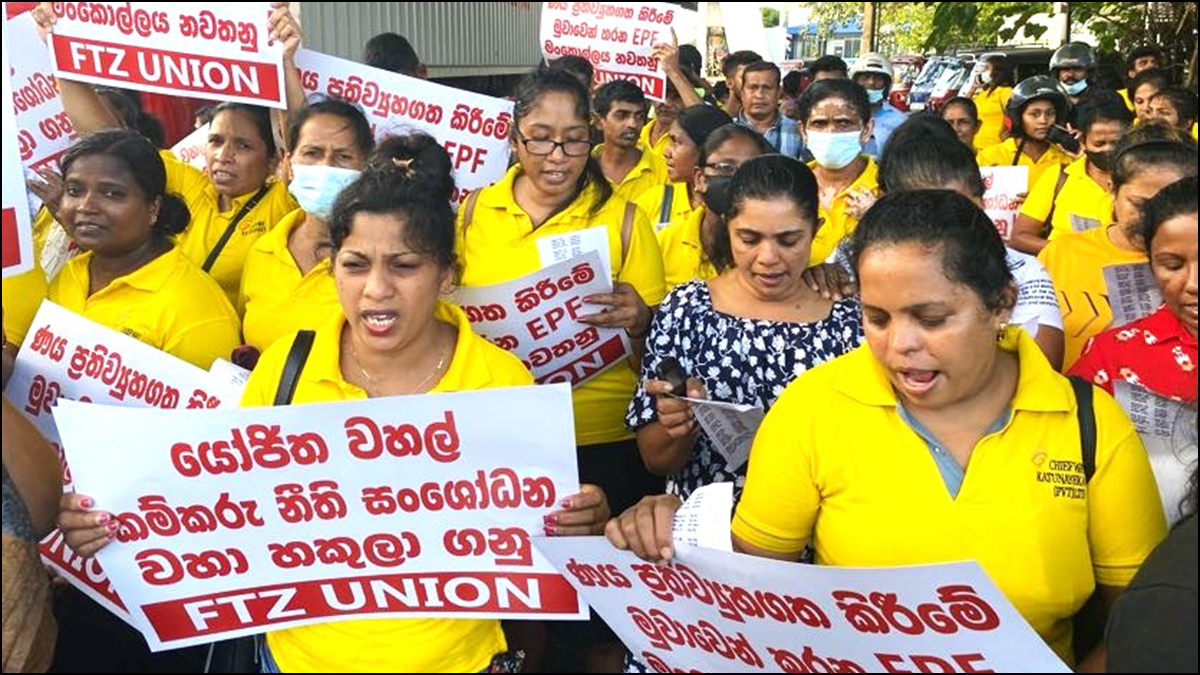
Let me say this straight and clear. “Sri Lanka has not gained anything on EU conditions laid down to qualify Sri Lanka for EU GSP+ post-Tsunami special offer”. What does the EU offer us and what have we to comply with?
EU offers “zero duty” exports for over 700 listed Sri Lankan products including apparels, rubber and fish products, bicycles, toys, tea and spices, electrical parts and few others to the EU market. That means, though our present basket is limited, over 700 Sri Lankan products can be sold in the EU market at subsidised “zero duty” prices, hopefully gaining increasing volumes. But who gains on increased value on sales?
With heavy corruption across geographical borders including money laundering, this is one major question that is not being asked and answered in detail by the government nor by the manufacturers. What is manufactured here for exports are exclusive “orders” from “Brands” received by product manufacturing companies through “Suppliers” on quoted and agreed prices. They not only have agreed prices, but agreed deadlines in handing over the finished product with pre-defined quality standards. What it means is, a “supplier” brings an order from a global “brand” and a manufacturing company with BOI-SL approval located in Sri Lanka that accepts the order is paid for its manufacture. That product is sold in a consumer market including the EU by its “brand” at a price fixed by the “brand”.
Once the supplier takes over the product from the Sri Lankan manufacturer, we don’t have anything to do with its sales in any consumer market. In simpler language, we don’t have anything to do with the product, once it leaves Colombo port. This too is important. The “zero duty” export concession is provided to listed Sri Lankan products and not to Sri Lanka. It is therefore enjoyed by the “brand” that owns the “product label”, perhaps with a share to the “supplier” on pre-agreed terms. May be, the SL manufacturer too gets “something” through the “supplier”, but that is wholly unofficial and out of public gaze. But for sure, that does not reach Sri Lanka and is not Sri Lanka’s gain.
What are we as a country expected to comply with, to continue with this GSP+ that brings us no economic benefits? First qualification is, Sri Lanka has to remain below the “Upper Middle Income” (UMI) category of countries. Thereafter, Sri Lankan government has to ensure implementation of 27 International Conventions that cover human rights, labour standards and rights, environmental protection and good governance. This does not mean ratification of “conventions” that SL has done in most instances, but also effectively implementing them with new laws and legal amendments where necessary.
Beyond economics, this requirement in effectively and sustainably democratising the Sri Lankan society is definitely worth complying with. Yet, all through past years when EU GSP+ was effective and in operation, neither SL governments nor the EU were serious about any of the 27 international conventions the EU imposed on SL to implement. The EU has sent 03 or 04 GSP+ Review Missions to Sri Lanka during these 17 or 18 years, that met numerous agencies, groups and individuals including the Head of State, relevant ministers, Opposition Leader and politicians, private sector trade unions and funded civil society activists in Colombo. All such review missions left Sri Lanka with a nod for an extension of GSP+ though with reservations at times on delays in implementation, except in 2010 when the EU was under pressure from Tamil Diaspora groups after the civil war was declared over in 2009 May.
This suspension was effective till 2017 for 07 whole years. The new government elected in January 2015 thereafter re-applied for GSP+ in 2016 June. What is important to note is that, during the 07 years SL was denied the “comfort” of “zero tariff” exports to Europe, Sri Lanka’s exports did not drop. According to the “Brief on International Trade” published by the Department of Commerce in October 2021, during the 02 years after the withdrawal of GSP+ the value of Sri Lankan products sold in European markets totalled 01.8 billion Euro. A little more than what it was in 2016, the year before the GSP+ suspension. Surprisingly, the value of merchandise from Sri Lanka sold in European markets during the next few years increased to around 02 billion Euros, before SL regained GSP+ in 2017. It only means, with or without EU GSP+, Sri Lankan products would be there in the EU market.
What needs to be stressed is, 10 plus years of EU GSP+ in full operation (that excludes the suspension), private sector labour that manufacture all Sri Lankan products in the EU markets, have not gained even the basic right to association and therefore not even collective bargaining, except in 01 factory out of over 1,600 factories. Repeal of the notorious repressive law, the PTA that was promised to be repealed way back in 2017 by the then government, is now said to take few more months if it does happen under the present regime and the EU Review Mission seems “okay” with it too. Environmental safety is under an axe with continued deforestation no matter who the government is. Breakdown in law, organised crime and mega corruption that involves the State hierarchy as well, would speak volumes about what “good governance” goes through despite EU monitoring of EU GSP+ with regular extensions.
End of the day, if the EU is not serious about having their conditions implemented, and if Sri Lankan governments can go on dragging their promises for democratisation over decades with no economic gains either, we are only wasting our tariff and tax incomes in billions doled out as annual incentives topping up free infrastructure provided to foreign direct investors, expecting them to provide us with much wanted forex. We need something more than a forensic audit to see how much we have lost as incentives given to export manufacture, a seriously corrupt sector most do not speak about.
That’s a wee bit about EU GSP+ and we Sri Lankans for now.
– Kusal Perera
2025 May 02

Chinese Minister of Commerce meets President AKD

Polish FM meets President AKD



